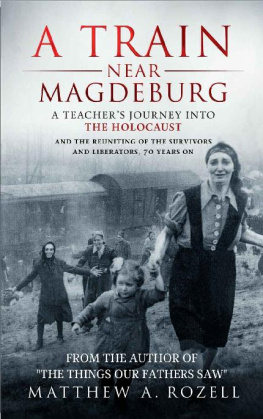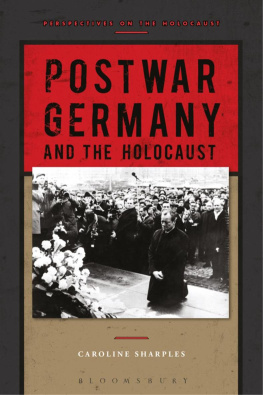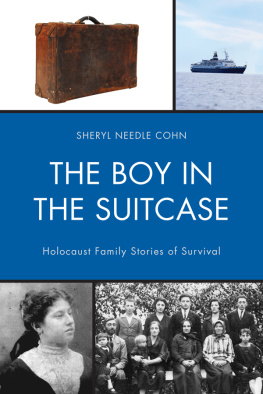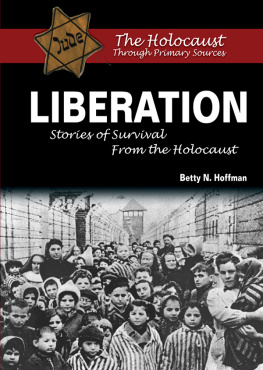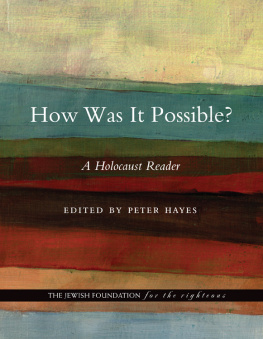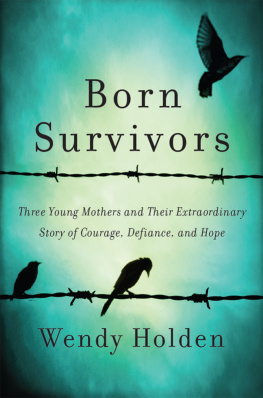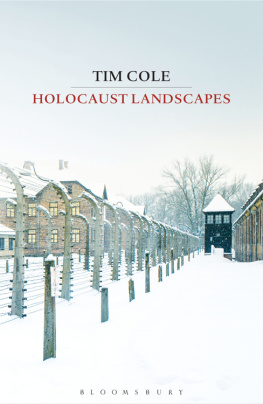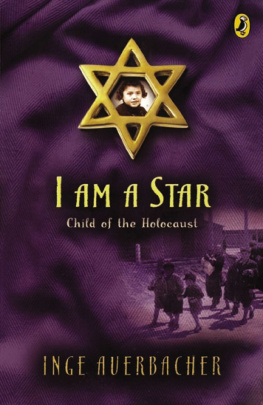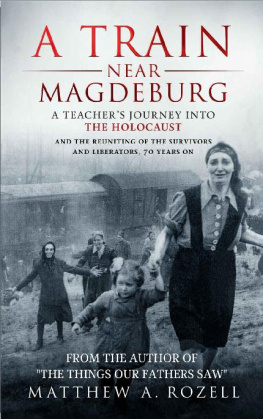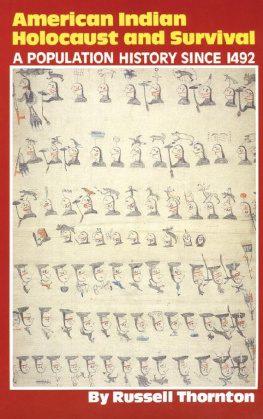A Train
Near Magdeburg
A TEACHERS JOURNEY
INTO THE HOLOCAUST
Matthew A. Rozell
Woodchuck Hollow Press
Hartford New York
Copyright 2016 by Matthew A. Rozell. Rev. 5.30.2018(GOK). All rights reserved. No original part of this publication may be reproduced, distributed, or transmitted in any form or by any means without the prior written permission of the publisher. Grateful acknowledgement is made to the following authors for the use of edited excerpts of previously published material: Aliza Vitis-Shomron, Leslie Meisels, Fred Spiegel, and Peter Lantos. Please see author notes.
The conclusions reached in this work are solely those of the author and should not be attributed to any of the institutions mentioned in this book.
Information at woodchuckhollowpress@gmail.com.
Maps by Susan WinchellSweeney.
Front cover credit: Major Clarence L. Benjamin, 743 rd Tank Battalion.
Back cover photo credits: Twilight Studios; Kris Dressen, SUNY Geneseo.
A Train Near Magdeburg: A Teachers Journey into the Holocaust/ Matthew A. Rozell. 1st ed.
Publisher's Cataloging-in-Publication Data
Names: Rozell, Matthew A., 1961-
Title: A train near Magdeburg: a teacher's journey into the Holocaust, and the reuniting of the survivors and liberators, 70 years on / Matthew A. Rozell.
Description: Hartford, NY: Woodchuck Hollow Press, 2016. | Includes bibliographical references.
Identifiers: LCCN 2016912597 | ISBN 978-0-9964800-2-4 (paperback) | ISBN 978-0-9964800-3-1 (Kindle)
Subjects: LCSH: Holocaust survivors--Biography. | Holocaust, Jewish (1939-1945)--Germany--Biography. | Holocaust, Jewish (1939-1945)--Germany--Personal narratives. | World War, 1939-1945--Jews--Rescue--Germany. | World War, 1939-1945--Historiography. | BISAC: HISTORY / Holocaust. | HISTORY / Military / World War II.
Classification: LCC DS134.4 .R76 2016 (print) | LCC DS134.4 (ebook) | DDC 940.53/18092--dc23.
www.teachinghistorymatters.com
www.matthewrozell.com
Printed in the United States of America
A TRAIN NEAR MAGDEBURG
Battle-hardened veterans learn to contain their emotions, but it was difficult then, and I cry now to think about it. What stamina and regenerative spirit those brave people showed!
GEORGE C. GROSS, LIBERATOR
Never in our training were we taught to be humanitarians. We were taught to be soldiers.
FRANK W. TOWERS, LIBERATOR
[After I got home] I cried a lot. My parents couldnt understand why I couldnt sleep at times.
WALTER BABE GANTZ, US ARMY MEDIC
I cannot believe, today, that the world almost ignored those people and what was happening. How could we have all stood by and have let that happen? They do not owe us anything. We owe them, for what we allowed to happen to them.
CARROL S. WALSH, LIBERATOR
I grew up and spent all my years being angry. This means I dont have to be angry anymore.
PAUL ARATO, HOLOCAUST SURVIVOR
Its not for my sake, its for the sake of humanity, that you will remember.
STEPHEN B. BARRY, HOLOCAUST SURVIVOR
A TRAIN NEAR MAGDEBURG
Table of Contents
June 6, 1944
Amsterdam
'This is D-Day, the BBC announced at 12 o'clock. This is the day. The invasion has begun!
Is this really the beginning of the long-awaited liberation? The liberation we've all talked so much about, which still seems too good, too much of a fairy tale ever to come true?... The best part of the invasion is that I have the feeling that friends are on the way. Those terrible Germans have oppressed and threatened us for so long that the thought of friends and salvation means everything to us!
Anne Frank, diary entry, six days before her 15 th birthday
April 15, 1945
Somewhere in Germany
Dear Mr. Huppert,
You will probably be wondering who I am and what business I have, writing to you. I am one of the millions of soldiers of the United States Army, who is fighting for all the oppressed peoples of the world and hopes to have reestablished decency and honor to all mankind, with the defeat of Hitlerism.
Two days ago, it was the privilege of our unit to be able to liberate a trainload full of people of all nations imaginable, who were being transferred from a concentration camp near Hannover to some other place. Our advances were so swift that the SS guards left this particular train where it was and took off.
That is how I became acquainted with your wife, Mrs. Hilde Huppert, who asked me to drop you this note saying that both she and your son Tommy are both healthy and well, and now being well taken care of by our military governmental authorities. In actual fact, your wife wrote a message for you on a piece of paper in pencil, which she asked me to convey to you. Unfortunately, however, the penciled lines faded in my pocket, and I can no longer read what was written on it. The contents of the message, though, were to let you know that your wife and son are both safe and sound.
I am sure that your wife will soon be able to get into contact with you directly through the Red Cross, and I hope that in a none too distant future, your family will once more be peacefully united.
Sincerely yours,
Cpl. Frank Gartner
rd Tank Battalion
Preface
A photograph taken by an Army major seventy years ago flickers to life on the screen. In it, a profound drama unfolds before the eye. The caption on the museum website reads:
A female survivor and her child run up a hill after escaping from a train near Magdeburg and their liberation by American soldiers from the 743 rd Tank Battalion and 30 th Infantry Division.
Record Type: Photograph
Date: 1945 April 13
Locale: Farsleben, [Prussian Saxony] Germany
Photographer: Clarence Benjamin
Photo Designation: LIBERATION
Germany: General
Train to Magdeburg/Farsleben
Keyword:
CHILDREN (03 YEARS)
CHILDREN/YOUTH
SURVIVORS
TRAINS
WOMEN
The picture defies expectations. When the terms Holocaust and trains are paired in an online image search, the most common result is that of people being transported to killing centersbut this incredible photograph shows exactly the opposite. And there are many things about this story that will defy expectations. Fifteen years after I brought this haunting image to the light of day, it has been called one of the most powerful photographs of the 20 th century. It has been used by museums and memorials across the world, in exhibitions, films, mission appeals, and photo essays. Schoolchildren download it for reports; filmmakers ask to use it in Holocaust documentaries. Yad Vashem, the Israeli Holocaust Martyrs and Heroes Remembrance Authority, even employed it as the backdrop for Israels state ceremonies in the presence of survivors, their president, prime minister, the entire government, top army brass, and the chief rabbi in a national broadcast on the 70 th anniversary of the liberation and aftermath of the Holocaust. I know, because they reached out to me for itme, an ordinary public school teacher, six thousand miles away.
For over half a century, a copy of this photograph and others were hidden away in a shoebox in the back of an old soldiers closet. By spending time with this soldier, I was able to set in motion an extraordinary confluence of events that unfolded organically in the second half of my career as a history teacher. Many of the children who suffered on that train found me, and I was able to link them forever with the men who I had come to know and love, the American GIs who saved them that beautiful April morning. A moment in history is captured on film, and we have reunited the actors, the persecuted, and their liberators, two generations on.
*
It is a cool spring morning. In the background, down the hill, are two cattle cars. If we look closely, we can see a figure sitting on the edge of the opening of a boxcar, perhaps too weak to climb out yet soaking up some energy from the warming April sun. In front of him, a wisp of smoke seems to rise from a small makeshift fire that others have gathered around. The sound of gunfire is echoing nearby; a metallic clanking sound is growing louder at the top of the hill.

